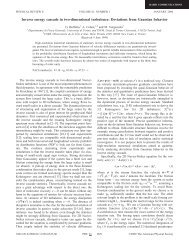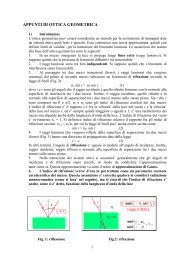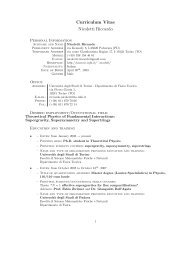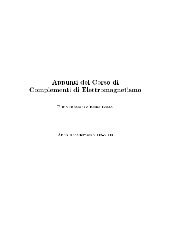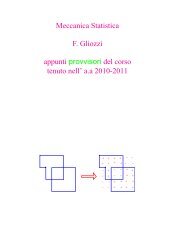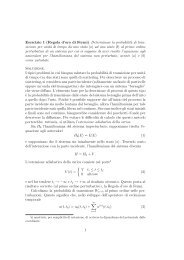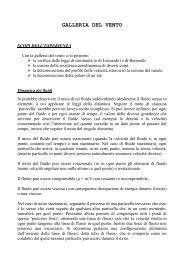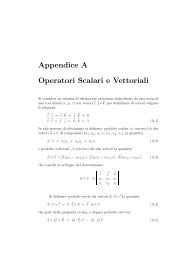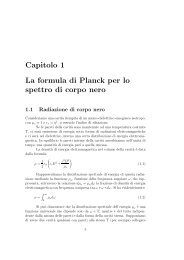Lezioni di Meccanica Quantistica Relativistica A. Bottino e C ... - INFN
Lezioni di Meccanica Quantistica Relativistica A. Bottino e C ... - INFN
Lezioni di Meccanica Quantistica Relativistica A. Bottino e C ... - INFN
You also want an ePaper? Increase the reach of your titles
YUMPU automatically turns print PDFs into web optimized ePapers that Google loves.
La funzioneK(t ′ ,⃗x ′ ; t,⃗x) ≡ ∑ nχ n (t ′ ,⃗x ′ ) χ ∗ n (t,⃗x) = ∑ nϕ n (⃗x ′ ) ϕ ∗ n (⃗x) e−iEn(t′ −t)(8.8)è la funzione <strong>di</strong> Green che fornisce l’evoluzione della funzione d’onda da (t,⃗x) a (t ′ ,⃗x ′ ):∫ψ(t ′ ,⃗x ′ ) = d 3 x K(t ′ ,⃗x ′ ; t,⃗x) ψ(t,⃗x) . (8.9)Osserviamo che per t ′ = t si haK(t,⃗x ′ ; t,⃗x) = δ 3 (⃗x ′ − ⃗x) . (8.10)Imponiamo la con<strong>di</strong>zione t ′ ≥ t, includendo una funzione θ(t) nella definizione <strong>di</strong>K(x ′ , x):K(x ′ , x) = ∑ χ n (t ′ ,⃗x ′ ) χ ∗ n (t,⃗x) θ(t′ − t) . (8.11)nSe applichiamo alla funzione K(x ′ , x) l’operatore i ∂ − H(⃗x ′ ), otteniamo∂t ′[i ∂ ]− H(⃗x ′ ) K(x ′ , x) = ∑ {[i ∂ ] }∂t ′ ∂t − ′ H(⃗x′ ) χ n (t ′ ,⃗x ′ ) χ ∗ n(t,⃗x) θ(t ′ − t)n+ ∑ χ n (t ′ ,⃗x ′ ) χ ∗ n (t,⃗x) i ∂∂t ′ θ(t′ − t) . (8.12)nIl primo termine del secondo membro è nullo e quin<strong>di</strong>, tenuto conto che dθ(t) = δ(t),dt[i ∂ ]∂t − ′ H(⃗x′ ) K(x ′ , x) = i δ 3 (⃗x ′ − ⃗x) δ(t ′ − t) . (8.13)Questa proprietà può essere utilizzata per generalizzare la definizione <strong>di</strong> K(x ′ , x) al casoin cui H <strong>di</strong>pende dal tempo.Nel caso <strong>di</strong> una teoria perturbativa, in cui l’operatore hamiltoniano H viene scrittocome H 0 + V , e V viene trattato come perturbazione, si ha∫K(x ′ , x) = K 0 (x ′ , x) − i d 4 x 1 K 0 (x ′ , x 1 ) V (x 1 ) K(x 1 , x) , (8.14)dove K 0 (x ′ , x) è la funzione <strong>di</strong> Green per H = H 0 (ossia V = 0). Infatti, applicandol’operatore i ∂ − H∂t ′ 0 (x ′ ) ad ambo i membri della (8.14) si ottiene[i ∂ ]∫∂t − H 0(x ′ ) K(x ′ , x) = i δ 4 (x ′ − x) + d 4 x ′ 1 δ 4 (x ′ − x 1 ) V (x 1 ) K(x 1 , x)= i δ 4 (x ′ − x) + V (x ′ ) K(x ′ , x) , (8.15)ossia [i ∂ ]− H(x ′ ) K(x ′ , x) = i δ 4 (x ′ − x) . (8.16)∂t ′77




